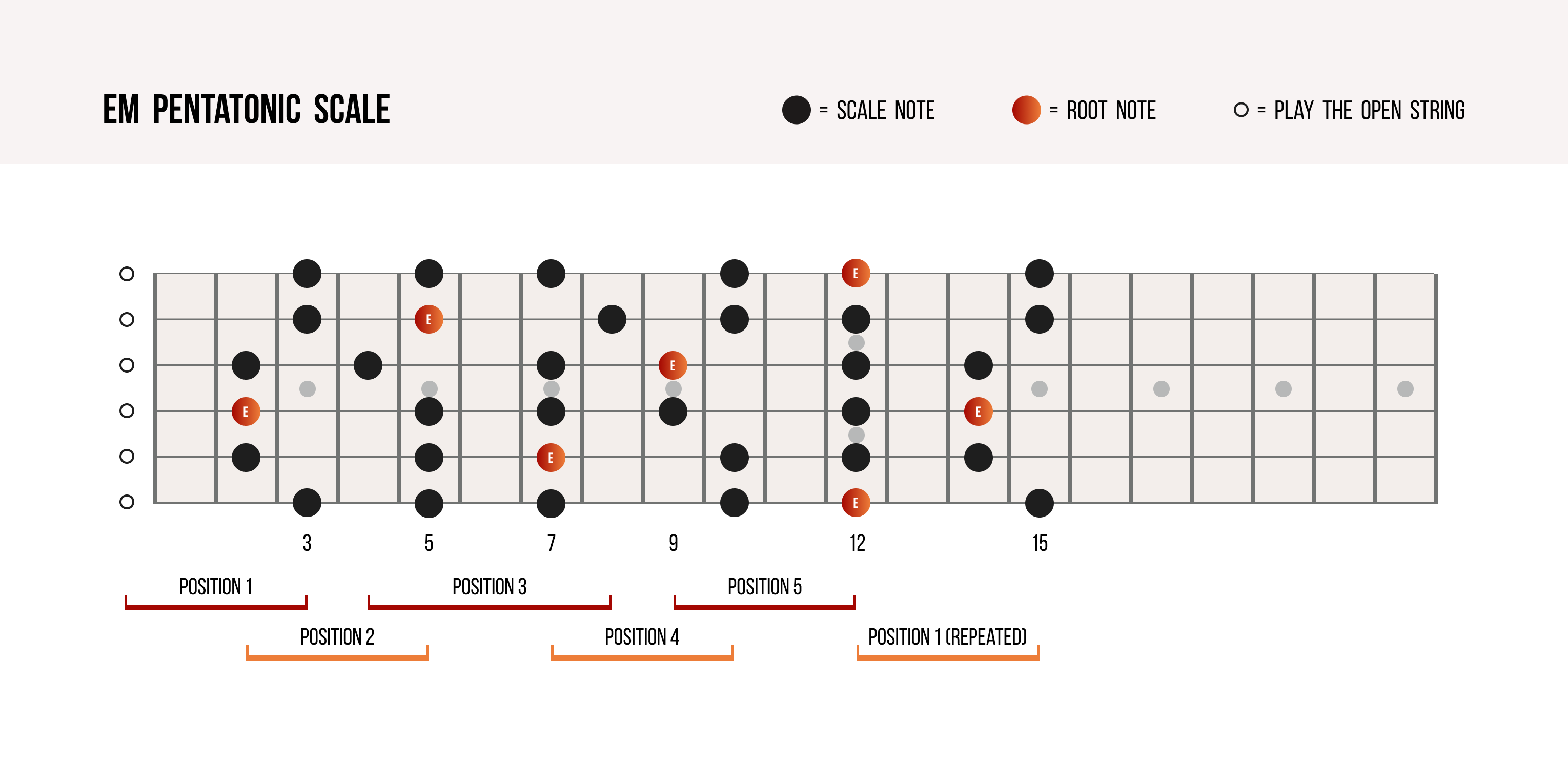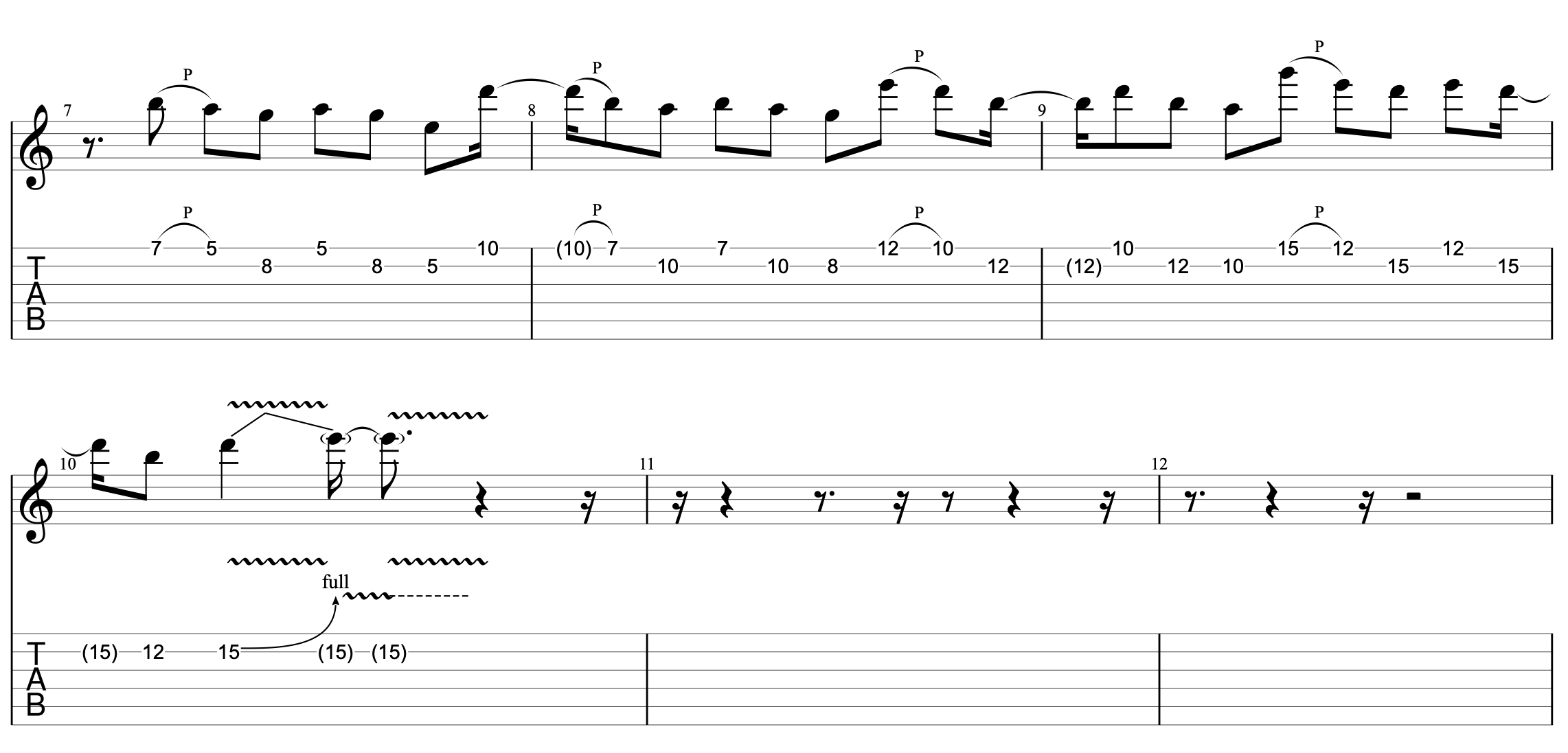Now that we’ve been introduced to what exactly the Minor Pentatonic Scale (see: Introduction to the Minor Pentatonic Scale), lets look at ways we can use the scale to fuel our lead guitar playing. In order to set the fretboard on fire like the greats, we first have to get a feel for how the scale feels when played in a musical context. Let’s start by familiarising ourselves with the Pentatonic shapes across the neck in Em. Play through the following notes over an E minor backing track (https://youtu.be/9FEjIfe4T60?feature=shared) and you should be able to hear how great they all sound. Make sure to pay attention to where the root note is and how it sounds when you land on this note.

Now that you’ve had a play through the scale, in the context of E Minor, you should notice how great all of the notes sound. However, just running up and down the notes isn’t very musical and exciting. Although the notes fit, they seem to be missing something. This is where licks and riffs come in. When you combine playing the notes (the why) with guitar techniques (the how) you start to create melodies and motifs (a repeating, identifiable lick or riff) to create music. After all, that’s what we’re all trying to do, right?
Popular Examples
Let’s look at some famous songs that heavily use the E Minor Pentatonic Scale to legendary effect. I’ll keep within the key of E Minor for simplicity in the this lesson, but there are so many other examples in a variety of other keys.
AC/DC – Back in Black (riff)
The Young brothers have used the pentatonic to blistering effect throughout their career and we are all extremely grateful. This all time classic riff uses a combination of chords from the E minor natural scale (first chord – Em, fourth chord – Am, and the seventh chord – D) and a tasty lick using position 1 of the Em pentatonic scale. The reason this works so well with the E Minor Pentatonic Scale is down to the use of power chords. I’ll be doing a deep dive into power chords in a later lesson but for now, just know that it’s a basic version of a chord and therefore keep things simple. Let’s have a look at the riff:

Note: If you’re wondering about the ‘extra notes’ in bar 4 that don’t belong to the E Minor Pentatonic Scale, don’t worry. This brings in the blues scale and uses a classic blues technique to walk up to a chord that we want to resolve to. We’ll be introduced to the blues and it’s scales in future lessons. For now, just focus on the use of position 1 in bar 2 and have a play of the E Minor over this legendary track.
The Doors – Break on Through to the Other Side
Another classic, this time from the psychedelic 70’s. The Doors were more than just Jim Morrison, the rest of the band were all legends in their own right and helped shaped all of their classic songs. Robby Krieger’s simple riff in E compliments Manzarek’s keyboard riff perfectly to provide the main groove behind this song.

Note: Watch the staccato notes E and D (played on the D string) as this makes the notes punchy and adds to the genius simplicity of this iconic riff.
Lenny Kravitz – Are You Gonna Go My Way
You might have placed Mr Kravitz squarely into the pop genre but you’d be missing out on some of the classic rock playing he has to offer. His friends and collaborators are all other all time legends (he went to school with Slash as an example), so you know Lenny’s rock chops are up there with the greatest. This riff showcases that in all its simple E Minor Pentatonic glory. A classic Hendrix style licks with a twist. Make sure to get this in your repertoire!

Lick practice!
Now that we’ve had a run through all the pentatonic positions and have seen how it has been used in riffs over the years to iconic effect, let’s turn our attention to some lead uses. Running up and down the scale notes is great to learn and get a feel for the pentatonic but the real fun comes when you start to learn and create your own licks. I promised a few licks so here are some common ones that have been used by the greats to inspire you on your lead guitar journey.
Lick #1
Our first lick comes inspired from the genius of Paul Kossoff. Kossoff was a master of keeping things simple and effective but all the while being able to drench his playing in emotion and melody. This lick is based around a repeating motif in the 4th position of the Em Pentatonic Scale (see diagram at the top of the article for reference). Make sure to add that vibrato on the last full-tone bend of the A note up to the B (10th fret) to really get that emotional impact.

Lick #2
Here’s a classic descending run using the 1st position at the 12th fret. The likes of the great Jimmy Page used this to great effect in songs such as Good Time Bad Times. The lick consists of a repeating pattern utilising pull offs and starting at the G note at fret 15, all the way down to end on the root of E (14th fret). Consistency is key with this one. Make sure to play all notes equally to get that fluid descending movement.

Lick #3
The last example is a slightly trickier pattern that ascends up the fret board a la Paul Gilbert. Ascending runs are a great way to not only get familiar with all the different Pentatonic shapes across the fretboard, but can also add a sense immediacy and excitement to a lead break. The lick ends back on the root note by bending into the E from the D note on the 15th fret which resolves this lick nicely.

And that’s a few ways you can incorporate this essential scale into your guitar playing arsenal. Stay tuned for more lessons and insights into common scales and how to use them!
